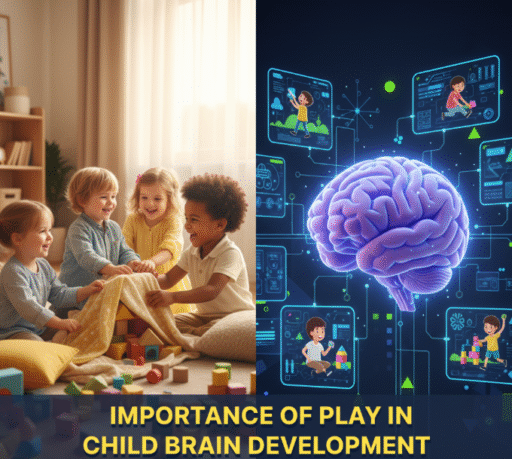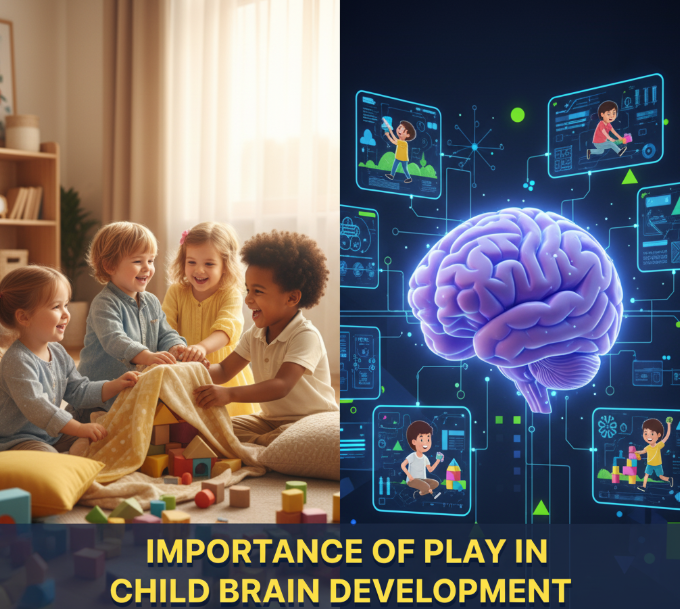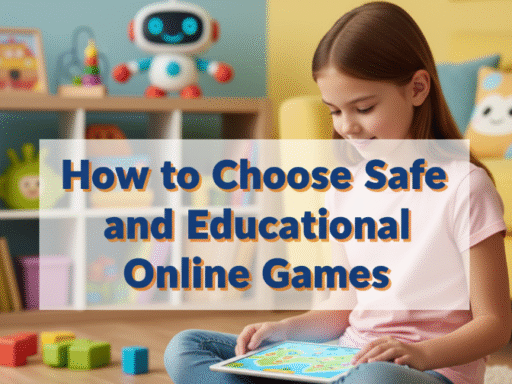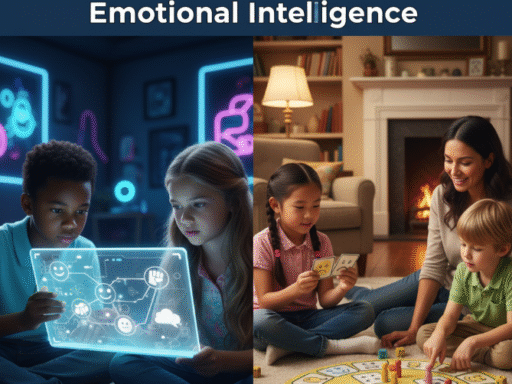Introduction
When we think of play, we often imagine kids running around, laughing, building blocks, or inventing make-believe worlds. Many parents see it as just “fun time” or a way to keep kids busy. But play is much more than entertainment. It’s a critical part of childhood that shapes how a child’s brain develops, learns, and functions in the future.
Play is nature’s built-in learning tool. It’s through play that children discover how the world works, how to solve problems, how to interact with others, and how to express creativity. From boosting memory and attention span to strengthening problem-solving skills, play is like exercise for the brain.
In this article, we’ll explore the importance of play in child brain development, looking at how different types of play help shape intelligence, emotions, and social growth. We’ll also cover the science behind play, provide examples, and share tips for parents and educators to encourage healthy play.
Why Play Matters for the Developing Brain
The human brain is not fully formed at birth. In fact, about 90% of brain growth happens by age five. During this time, neural connections are rapidly forming. Play stimulates these connections, reinforcing the brain’s ability to think, learn, and adapt.
Here’s why play is so important:
-
Enhances brain plasticity: Play helps the brain strengthen existing pathways and create new ones.
-
Boosts memory and attention: Games like puzzles or board games improve focus and recall.
-
Encourages creativity: Imaginative play fuels the brain’s ability to think outside the box.
-
Develops executive functions: Skills like planning, decision-making, and problem-solving are sharpened through structured play.
The Science Behind Play and Brain Growth
Research in neuroscience shows that play stimulates the prefrontal cortex, the brain region responsible for decision-making, emotional regulation, and social behavior.
Key Brain Areas Activated During Play:
| Brain Region | Role in Development | Example of Play That Stimulates It |
|---|---|---|
| Prefrontal Cortex | Planning, focus, self-control | Strategy games, role-play |
| Hippocampus | Memory and learning | Storytelling, reading games |
| Cerebellum | Coordination, balance | Running, climbing, dancing |
| Amygdala | Emotional responses | Pretend play, drama activities |
When children play, chemicals like dopamine and endorphins are released. These “feel-good” chemicals reduce stress, improve mood, and make learning enjoyable.
Types of Play That Shape Brain Development
Not all play is the same. Different activities stimulate different parts of the brain. Let’s explore the major types of play and how they support brain growth.
1. Physical Play
This includes running, jumping, climbing, or playing ball games.
-
Benefits:
-
Strengthens motor skills and coordination
-
Improves blood flow to the brain
-
Reduces stress hormones
-
Boosts memory and focus
-
Example: Playing tag sharpens reflexes, teaches rule-following, and encourages social bonding.
2. Constructive Play
Building with blocks, solving puzzles, or creating structures with LEGO.
-
Benefits:
-
Encourages problem-solving
-
Develops spatial awareness
-
Improves concentration
-
Builds planning skills
-
Example: When a child builds a tower with blocks, they learn balance, prediction, and trial-and-error problem-solving.
3. Pretend or Imaginative Play
Children act out scenarios like being a teacher, superhero, or chef.
-
Benefits:
-
Enhances creativity and innovation
-
Builds empathy and emotional intelligence
-
Strengthens language and storytelling skills
-
Helps children process emotions and fears
-
Example: Pretending to run a shop teaches math (counting money), communication, and negotiation.
4. Social Play
Games with peers, like board games, group sports, or playground activities.
-
Benefits:
-
Develops teamwork and cooperation
-
Teaches conflict resolution
-
Builds leadership and negotiation skills
-
Strengthens friendships and social bonds
-
Example: Playing soccer teaches strategy, patience, and working toward a common goal.
5. Educational Play
Activities designed with a learning purpose, like memory games, word puzzles, or math-based board games.
-
Benefits:
-
Strengthens academic skills
-
Makes learning fun and interactive
-
Improves logic and reasoning
-
Boosts motivation for schoolwork
-
Example: A word puzzle improves spelling and vocabulary while being enjoyable.
Cognitive Benefits of Play
Better Problem-Solving Skills
When kids play with puzzles or strategy-based games, they learn to experiment, fail, and try again. This trial-and-error process builds resilience and flexible thinking.
Stronger Memory and Focus
Games with rules, like chess or “Simon Says,” help children improve working memory and attention span.
Creativity and Innovation
Pretend play fuels imagination, encouraging children to think beyond what’s in front of them and invent new ideas.
Emotional Benefits of Play
-
Stress Relief: Play reduces cortisol levels, helping children relax.
-
Emotional Expression: Pretend play gives kids a safe outlet for expressing fears and emotions.
-
Confidence Building: Winning a game or solving a puzzle gives children a sense of accomplishment.
Social Benefits of Play
-
Learning to share and take turns
-
Understanding teamwork and leadership
-
Building empathy through role-play
-
Improving communication skills
How Much Play Do Kids Need?
Experts recommend that children have at least 60 minutes of free play daily, in addition to structured learning. The more diverse the play activities, the better for overall brain growth.
Play vs. Screen Time: Striking a Balance
Modern kids spend more time with screens than ever before. While digital games can have some benefits, too much screen time reduces physical play, creativity, and social interaction.
Table: Play vs. Screen Time Effects
| Aspect | Active Play | Excessive Screen Time |
|---|---|---|
| Physical Health | Builds strength, motor skills | Risk of obesity, poor posture |
| Brain Development | Boosts creativity, problem-solving | Reduced attention span |
| Social Skills | Improves teamwork, empathy | Isolation, weak social interaction |
| Emotional Health | Reduces stress, builds confidence | Anxiety, mood swings |
Parents should encourage balanced play, mixing outdoor activities, creative games, and limited educational screen use.
Tips for Parents to Encourage Play
-
Create a Play-Friendly Environment
-
Provide safe outdoor and indoor spaces.
-
Keep a variety of toys and learning materials.
-
-
Join in the Play
-
Playing with your child strengthens bonds.
-
It also shows children that play is valuable.
-
-
Encourage Free Play
-
Avoid over-scheduling with only structured activities.
-
Give children freedom to invent their own games.
-
-
Limit Screen Time
-
Set daily limits on TV, tablets, and video games.
-
Replace screen time with physical or social play.
-
-
Mix Different Types of Play
-
Encourage a balance of physical, imaginative, and educational games.
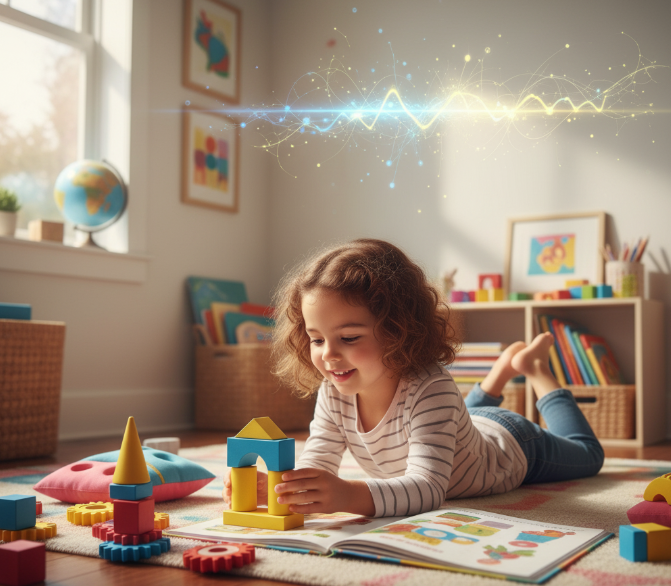
Importance of Play in Child Brain Development
-
Real-Life Examples of Play in Brain Development
-
Einstein and Imaginative Play: Albert Einstein credited his creativity and problem-solving abilities to hours of daydreaming and imaginative play.
-
Montessori Education: The Montessori method emphasizes hands-on learning through play, showing significant improvements in problem-solving and emotional intelligence.
Infographic: Stages of Play and Brain Development
(Imagine a simple infographic showing growth stages)
-
Infant (0–2 years): Sensory play (touching, feeling, exploring).
-
Toddler (2–4 years): Simple pretend play, building blocks.
-
Early Childhood (4–7 years): Role-play, group games, puzzles.
-
Middle Childhood (7–12 years): Strategy games, team sports, creative projects.
Future Impact of Play on Learning and Success
Play doesn’t just prepare kids for school; it sets them up for life. The skills gained—creativity, resilience, teamwork, emotional regulation—are the same skills needed in adulthood for problem-solving, leadership, and innovation.
Companies today look for employees who can think critically, collaborate effectively, and adapt quickly. All these traits are rooted in childhood play.
Conclusion
Play is not a luxury—it’s a necessity. It is the foundation for a child’s brain development, shaping how they think, feel, and interact with the world. From improving memory and problem-solving skills to building emotional intelligence and social confidence, play has lifelong benefits.
Parents, teachers, and caregivers must view play as essential as food, sleep, and education. By creating a balance of physical, imaginative, and social play, we give children the best chance to grow into happy, intelligent, and well-rounded adults.
So next time you see a child building a LEGO tower, running on the playground, or pretending to be a doctor—remember, they’re not just playing. They’re building the brainpower that will guide them for the rest of their lives.
